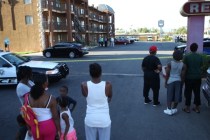More adults than children die in the desert heat

Deaths of children left inside vehicles when temperatures climb grip the public’s attention, but in fact more adults than children die from Las Vegas Valley’s heat.
And when it comes to dying from heat, about as many nonresidents have died compared to residents in the past decade.
From 2005 to Aug. 31, the primary cause of death for 124 people who died in Clark County was environmental heat stress, environmental exposure or hyperthermia, according to Clark County coroner’s office data. Sixty-six were residents of Clark and Nye counties, and the rest did not have addresses except two from nearby states and one from overseas.
Nine percent who died of heat were residents of Clark or Nye counties and under the influence of alcohol or drugs. Thirteen percent who died of heat, mostly without an address, were under the influence of alcohol or drugs, according to data.

“Not a lot of kids die from heat,” Clark County Coroner John Fudenberg said. “There are one or two (child deaths), and we hear about it and we think they’re common, but they are not.”
As of Aug. 31, 15 deaths — two Clark County residents and 13 people with no addresses — have been attributed to heat this year in Clark County’s desert environs.
Of those, only one was a child.
Four-year-old Las Vegan Seth Franz died after he was left in a car for at least two hours in August, according to Las Vegas police.
Seth’s grandfather was running errands and forgot the boy was in the car, police said.
In the past decade, there have only been three child deaths, including Seth’s, where the primary cause was heat. One of those three deaths was ruled a homicide.
Jozia Diaz-Beltran, a 1-year-old, died of heat in 2005. The child also was forgotten inside a hot car by a family member.
Jason Rimer, a 4-year-old disabled boy, in 2008 was left in a hot vehicle by his parents. Stanley and Colleen Rimer were convicted in their son’s death in 2011. The Nevada Supreme Court in June upheld the convictions against Jason’s father, who was sentenced to eight to 30 years in prison. The mother was sentenced to five to 20 years in prison in 2011.
From Jan. 1 through Aug. 31, local fire departments received 193 calls about children locked or left unattended in cars throughout Clark County, according to fire alarm call logs.
“Most, if not nearly all, are accidental lock-ins. It’s rare that a person intentionally leaves (his or her) child in the car to get something or go shopping, because here you can go to jail, and it has served as a great deterrent over the past 11 years,” Las Vegas Fire Department spokesman Tim Szymanski said.
A Contributing Cause
Heat is a contributing factor in many deaths, including those of children.

In 2005, it was listed as a contributing factor in the suicide of a 17-year-old. Heat also was a factor in the 2009 death of a 4-month-old, who had a bad heart.
But the majority of heat deaths in Clark County in the past decade were adults.
Dr. Joseph Iser, the county’s chief health officer, said children and the elderly are more at risk of heat-related illness or death.
The human thermoregulatory system, which gives people the ability to regulate their internal temperature, deteriorates with age. People with chronic diseases and those on certain medications might be more susceptible to the sun as well.
But so are tourists who are not used to the desert heat and don’t come prepared for it, Iser said.
The Southern Nevada Health District doesn’t have official campaigns targeting certain populations to prevent heat deaths, but it does offer preventive information to the public on its website.
It also posts information about cooling stations during streaks of excessive heat and notifies the media.
However, Iser said more can be done.
“I think any death is too much,” he said. “I think that as a county, as a state, we should probably do more to warn our visitors in particular about some of the hazards that we have here, and that’s not normally cold, but heat.”
But the health district can only do so much with the resources it has, he added, and it’s also up to people to take the warnings seriously.
“People have to understand their own risk,” he said.
The health district encourages people to stay hydrated, and to drink water even if they aren’t thirsty.
“Here we don’t usually sweat, so you don’t feel the dampness, which is a warning sign that you might be losing water,” he said. “You really need to remain vigilant year-round.”
Heat Warnings
But some might just not be able to help themselves. Of the 65 Clark County resident deaths over the past decade, four had an unknown ZIP code, which means they might have been homeless, Fudenberg said.
The death locations for those 65 Southern Nevadans spanned residences, streets, work sites, parking lots, desert areas, alleys and hospitals, according to the coroner’s data.
Justin Pullin, a meteorologist with the National Weather Service in Las Vegas, said whenever his agency issues excessive heat warnings, it typically causes something of a “domino effect” in terms of awareness.
That “definitely” helps prevent heat-related deaths, he said.
It prompts Clark County Emergency Management to send out information, which leads to the opening of cooling stations throughout the county.
“We typically … provide forecast briefings through email describing the severity of the heat and the duration,” Pullin said.
Clark County Social Services Department staff then reach out to various locations for the cooling stations, whose openings are triggered by excessive heat warnings, county spokesman Dan Kulin said.
The county began to organize cooling stations in 2009, he said. The county also contracts with Catholic Charities of Southern Nevada, the Salvation Army of Southern Nevada and the Shade Tree for summer day shelters, efforts that started in 2006.
There are typically 10 to 11 cooling stations throughout the valley and two in Laughlin.
“We have the day shelters and cooling stations to give the medically fragile, and anyone else who may need them on those days when it’s extremely hot outside,” he said. “Certainly, we hope that prevents people from becoming ill or worse.”
Contact Yesenia Amaro at yamaro@reviewjournal.com or 702-477-3843. Find her on Twitter: @YeseniaAmaro
One sure bet: Death in Las Vegas



















